Risk Management Strategies and Assessment: BSBRSK501
VerifiedAdded on 2022/08/21
|12
|2921
|15
Homework Assignment
AI Summary
This document presents a comprehensive risk management assessment, addressing the key elements of BSBRSK501. It begins by defining different types of risks, including operational, strategic, and external risks, and then outlines the purpose and key elements of current risk management standards. The assessment delves into the components of risk management, information sources for identifying risks, and the purpose of organizational policies and procedures. It includes a PESTLE analysis, stakeholder identification, and the meaning and purpose of risk criteria. The assessment also covers communication in risk management, risk identification tools, risk analysis components, the difference between qualitative and quantitative analysis, and the use of likelihood and consequence tables. It explains risk treatment options, cost-benefit analysis, and the factors to consider. The plan also includes documenting a risk management plan, the importance of frequent reviews, mechanisms for monitoring and updating the plan, and the role of legislation, codes of practice, and national standards. The final section of the assessment includes an analysis of the risk context, identifying strengths, weaknesses, opportunities, and threats, as well as the scope, objectives, and critical success factors of a project.
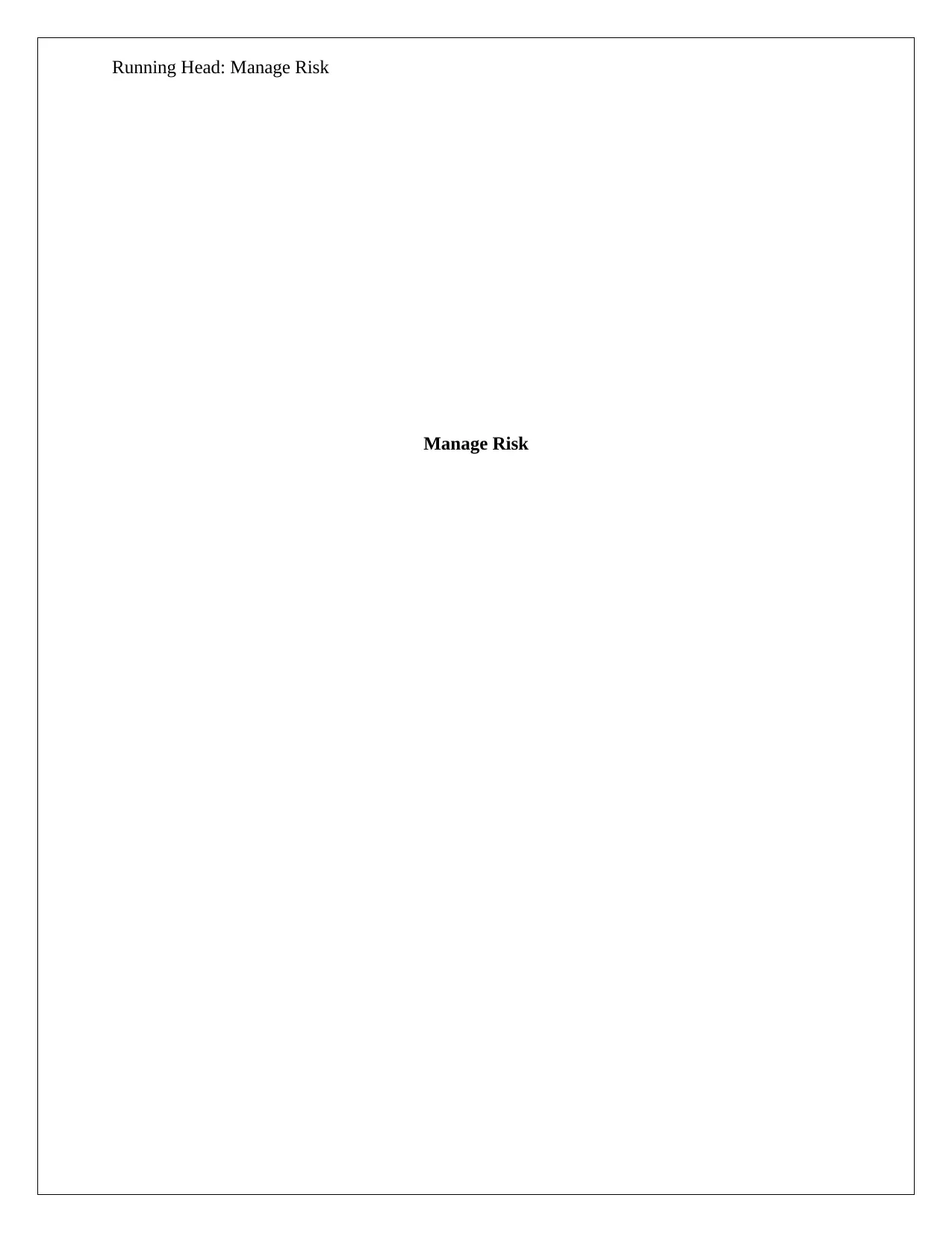
Running Head: Manage Risk
Manage Risk
Manage Risk
Paraphrase This Document
Need a fresh take? Get an instant paraphrase of this document with our AI Paraphraser
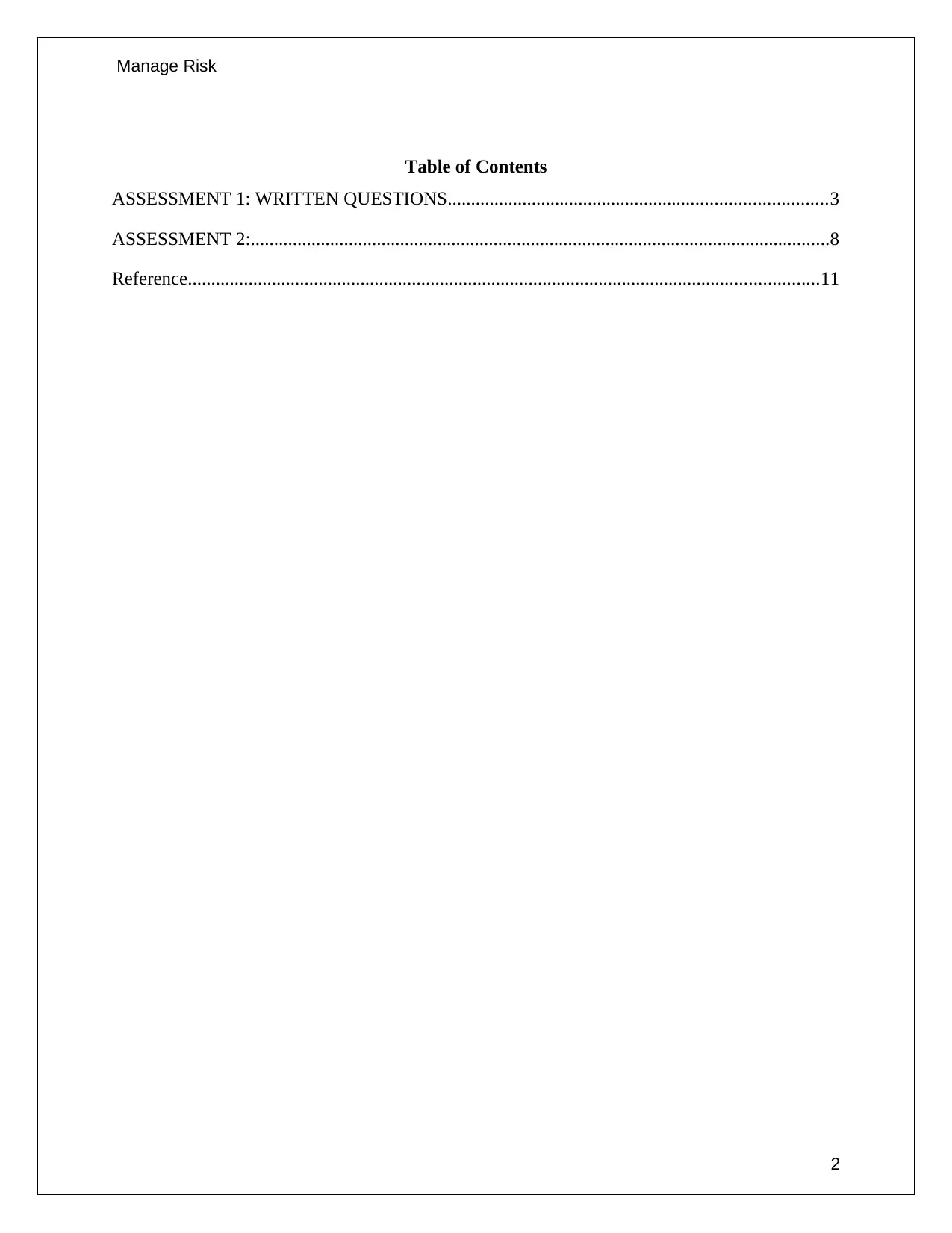
Manage Risk
Table of Contents
ASSESSMENT 1: WRITTEN QUESTIONS.................................................................................3
ASSESSMENT 2:............................................................................................................................8
Reference.......................................................................................................................................11
2
Table of Contents
ASSESSMENT 1: WRITTEN QUESTIONS.................................................................................3
ASSESSMENT 2:............................................................................................................................8
Reference.......................................................................................................................................11
2
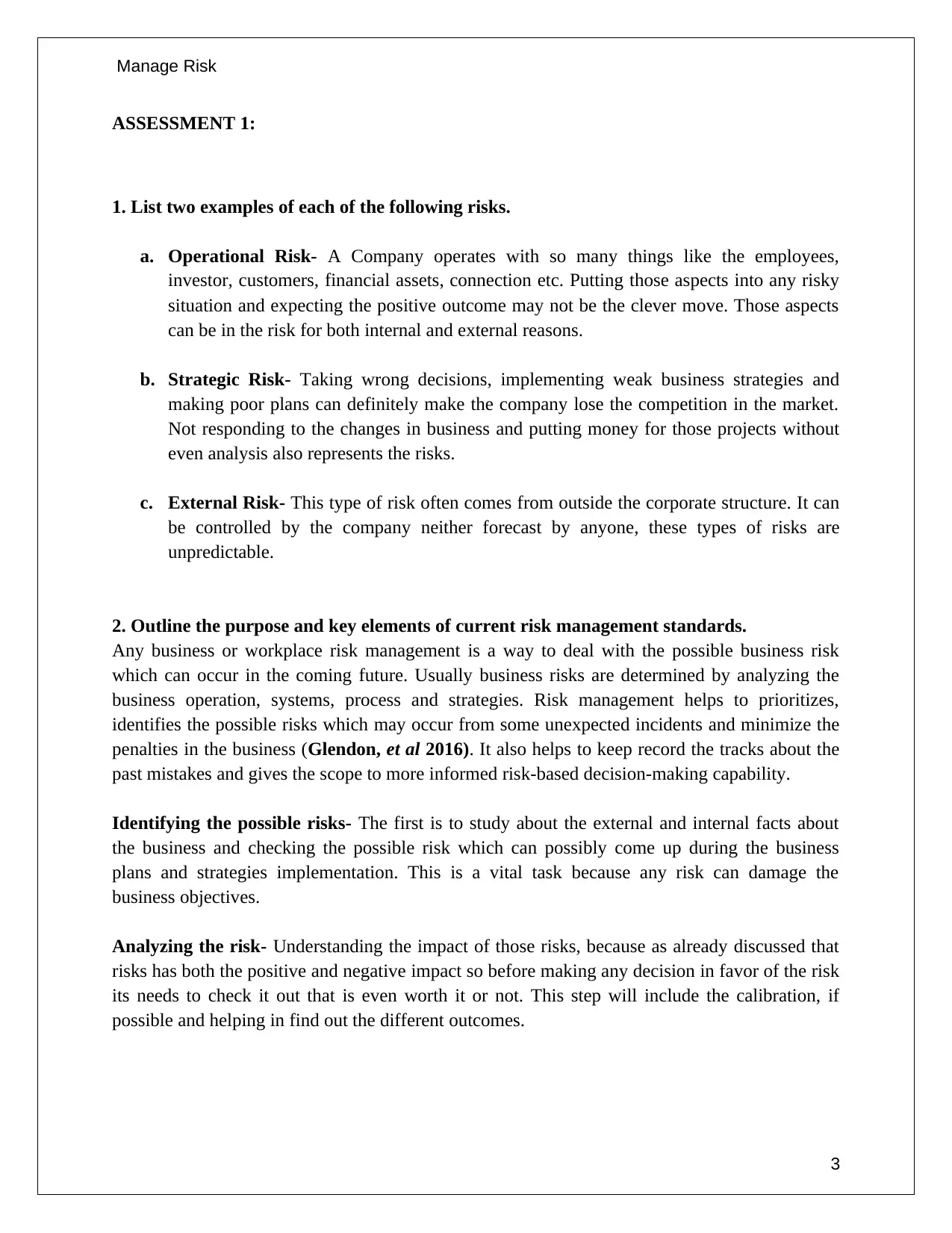
Manage Risk
ASSESSMENT 1:
1. List two examples of each of the following risks.
a. Operational Risk- A Company operates with so many things like the employees,
investor, customers, financial assets, connection etc. Putting those aspects into any risky
situation and expecting the positive outcome may not be the clever move. Those aspects
can be in the risk for both internal and external reasons.
b. Strategic Risk- Taking wrong decisions, implementing weak business strategies and
making poor plans can definitely make the company lose the competition in the market.
Not responding to the changes in business and putting money for those projects without
even analysis also represents the risks.
c. External Risk- This type of risk often comes from outside the corporate structure. It can
be controlled by the company neither forecast by anyone, these types of risks are
unpredictable.
2. Outline the purpose and key elements of current risk management standards.
Any business or workplace risk management is a way to deal with the possible business risk
which can occur in the coming future. Usually business risks are determined by analyzing the
business operation, systems, process and strategies. Risk management helps to prioritizes,
identifies the possible risks which may occur from some unexpected incidents and minimize the
penalties in the business (Glendon, et al 2016). It also helps to keep record the tracks about the
past mistakes and gives the scope to more informed risk-based decision-making capability.
Identifying the possible risks- The first is to study about the external and internal facts about
the business and checking the possible risk which can possibly come up during the business
plans and strategies implementation. This is a vital task because any risk can damage the
business objectives.
Analyzing the risk- Understanding the impact of those risks, because as already discussed that
risks has both the positive and negative impact so before making any decision in favor of the risk
its needs to check it out that is even worth it or not. This step will include the calibration, if
possible and helping in find out the different outcomes.
3
ASSESSMENT 1:
1. List two examples of each of the following risks.
a. Operational Risk- A Company operates with so many things like the employees,
investor, customers, financial assets, connection etc. Putting those aspects into any risky
situation and expecting the positive outcome may not be the clever move. Those aspects
can be in the risk for both internal and external reasons.
b. Strategic Risk- Taking wrong decisions, implementing weak business strategies and
making poor plans can definitely make the company lose the competition in the market.
Not responding to the changes in business and putting money for those projects without
even analysis also represents the risks.
c. External Risk- This type of risk often comes from outside the corporate structure. It can
be controlled by the company neither forecast by anyone, these types of risks are
unpredictable.
2. Outline the purpose and key elements of current risk management standards.
Any business or workplace risk management is a way to deal with the possible business risk
which can occur in the coming future. Usually business risks are determined by analyzing the
business operation, systems, process and strategies. Risk management helps to prioritizes,
identifies the possible risks which may occur from some unexpected incidents and minimize the
penalties in the business (Glendon, et al 2016). It also helps to keep record the tracks about the
past mistakes and gives the scope to more informed risk-based decision-making capability.
Identifying the possible risks- The first is to study about the external and internal facts about
the business and checking the possible risk which can possibly come up during the business
plans and strategies implementation. This is a vital task because any risk can damage the
business objectives.
Analyzing the risk- Understanding the impact of those risks, because as already discussed that
risks has both the positive and negative impact so before making any decision in favor of the risk
its needs to check it out that is even worth it or not. This step will include the calibration, if
possible and helping in find out the different outcomes.
3
⊘ This is a preview!⊘
Do you want full access?
Subscribe today to unlock all pages.

Trusted by 1+ million students worldwide
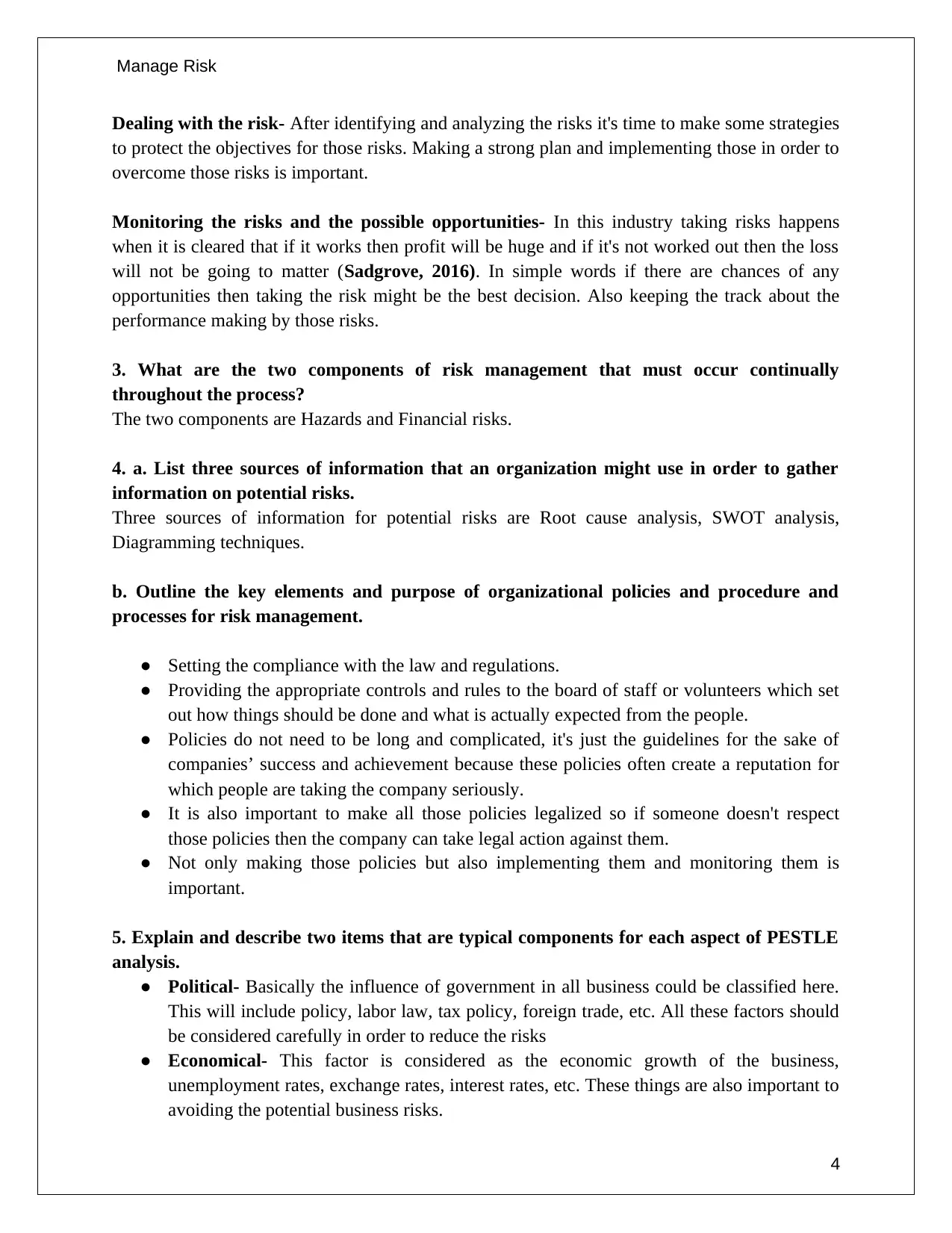
Manage Risk
Dealing with the risk- After identifying and analyzing the risks it's time to make some strategies
to protect the objectives for those risks. Making a strong plan and implementing those in order to
overcome those risks is important.
Monitoring the risks and the possible opportunities- In this industry taking risks happens
when it is cleared that if it works then profit will be huge and if it's not worked out then the loss
will not be going to matter (Sadgrove, 2016). In simple words if there are chances of any
opportunities then taking the risk might be the best decision. Also keeping the track about the
performance making by those risks.
3. What are the two components of risk management that must occur continually
throughout the process?
The two components are Hazards and Financial risks.
4. a. List three sources of information that an organization might use in order to gather
information on potential risks.
Three sources of information for potential risks are Root cause analysis, SWOT analysis,
Diagramming techniques.
b. Outline the key elements and purpose of organizational policies and procedure and
processes for risk management.
● Setting the compliance with the law and regulations.
● Providing the appropriate controls and rules to the board of staff or volunteers which set
out how things should be done and what is actually expected from the people.
● Policies do not need to be long and complicated, it's just the guidelines for the sake of
companies’ success and achievement because these policies often create a reputation for
which people are taking the company seriously.
● It is also important to make all those policies legalized so if someone doesn't respect
those policies then the company can take legal action against them.
● Not only making those policies but also implementing them and monitoring them is
important.
5. Explain and describe two items that are typical components for each aspect of PESTLE
analysis.
● Political- Basically the influence of government in all business could be classified here.
This will include policy, labor law, tax policy, foreign trade, etc. All these factors should
be considered carefully in order to reduce the risks
● Economical- This factor is considered as the economic growth of the business,
unemployment rates, exchange rates, interest rates, etc. These things are also important to
avoiding the potential business risks.
4
Dealing with the risk- After identifying and analyzing the risks it's time to make some strategies
to protect the objectives for those risks. Making a strong plan and implementing those in order to
overcome those risks is important.
Monitoring the risks and the possible opportunities- In this industry taking risks happens
when it is cleared that if it works then profit will be huge and if it's not worked out then the loss
will not be going to matter (Sadgrove, 2016). In simple words if there are chances of any
opportunities then taking the risk might be the best decision. Also keeping the track about the
performance making by those risks.
3. What are the two components of risk management that must occur continually
throughout the process?
The two components are Hazards and Financial risks.
4. a. List three sources of information that an organization might use in order to gather
information on potential risks.
Three sources of information for potential risks are Root cause analysis, SWOT analysis,
Diagramming techniques.
b. Outline the key elements and purpose of organizational policies and procedure and
processes for risk management.
● Setting the compliance with the law and regulations.
● Providing the appropriate controls and rules to the board of staff or volunteers which set
out how things should be done and what is actually expected from the people.
● Policies do not need to be long and complicated, it's just the guidelines for the sake of
companies’ success and achievement because these policies often create a reputation for
which people are taking the company seriously.
● It is also important to make all those policies legalized so if someone doesn't respect
those policies then the company can take legal action against them.
● Not only making those policies but also implementing them and monitoring them is
important.
5. Explain and describe two items that are typical components for each aspect of PESTLE
analysis.
● Political- Basically the influence of government in all business could be classified here.
This will include policy, labor law, tax policy, foreign trade, etc. All these factors should
be considered carefully in order to reduce the risks
● Economical- This factor is considered as the economic growth of the business,
unemployment rates, exchange rates, interest rates, etc. These things are also important to
avoiding the potential business risks.
4
Paraphrase This Document
Need a fresh take? Get an instant paraphrase of this document with our AI Paraphraser
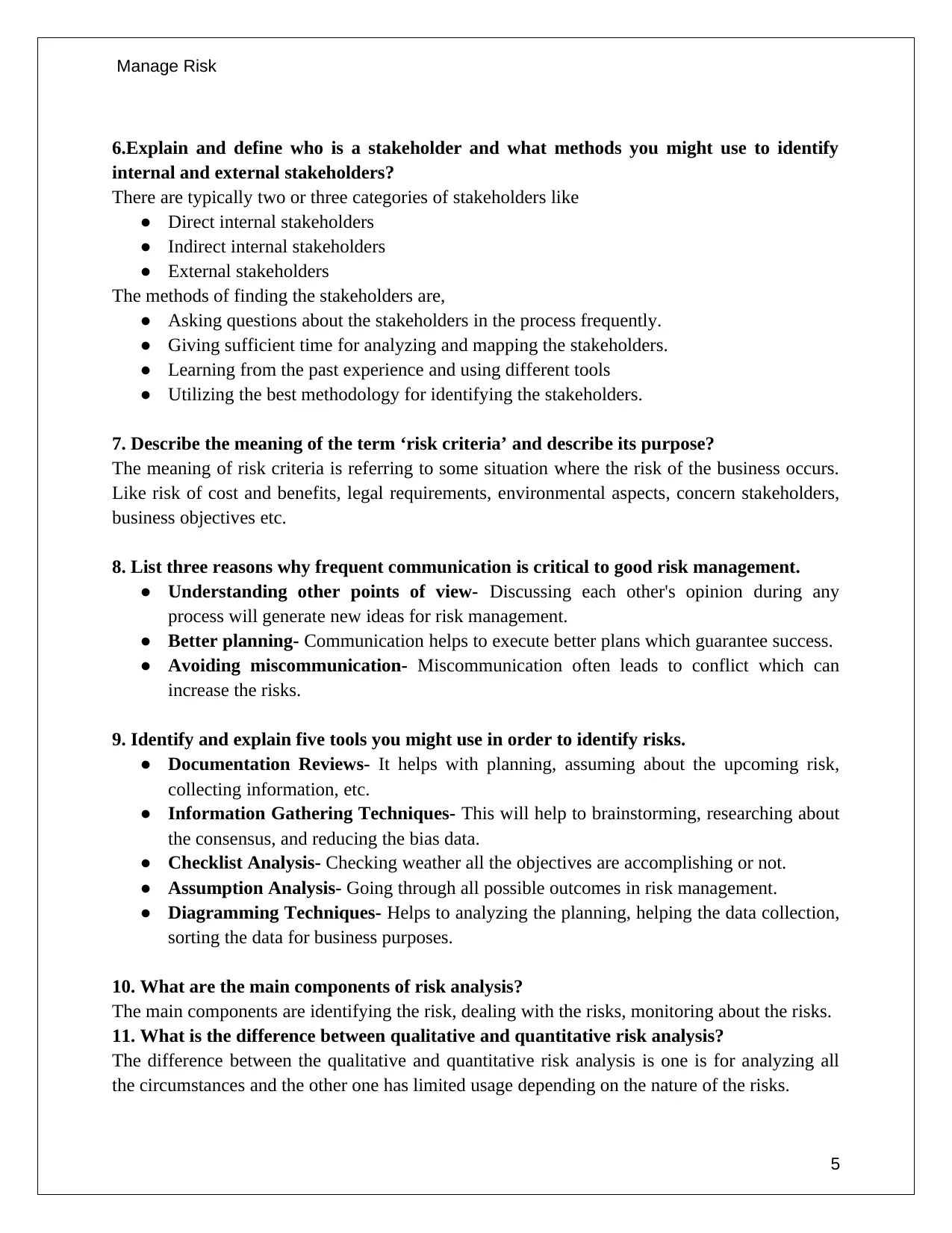
Manage Risk
6.Explain and define who is a stakeholder and what methods you might use to identify
internal and external stakeholders?
There are typically two or three categories of stakeholders like
● Direct internal stakeholders
● Indirect internal stakeholders
● External stakeholders
The methods of finding the stakeholders are,
● Asking questions about the stakeholders in the process frequently.
● Giving sufficient time for analyzing and mapping the stakeholders.
● Learning from the past experience and using different tools
● Utilizing the best methodology for identifying the stakeholders.
7. Describe the meaning of the term ‘risk criteria’ and describe its purpose?
The meaning of risk criteria is referring to some situation where the risk of the business occurs.
Like risk of cost and benefits, legal requirements, environmental aspects, concern stakeholders,
business objectives etc.
8. List three reasons why frequent communication is critical to good risk management.
● Understanding other points of view- Discussing each other's opinion during any
process will generate new ideas for risk management.
● Better planning- Communication helps to execute better plans which guarantee success.
● Avoiding miscommunication- Miscommunication often leads to conflict which can
increase the risks.
9. Identify and explain five tools you might use in order to identify risks.
● Documentation Reviews- It helps with planning, assuming about the upcoming risk,
collecting information, etc.
● Information Gathering Techniques- This will help to brainstorming, researching about
the consensus, and reducing the bias data.
● Checklist Analysis- Checking weather all the objectives are accomplishing or not.
● Assumption Analysis- Going through all possible outcomes in risk management.
● Diagramming Techniques- Helps to analyzing the planning, helping the data collection,
sorting the data for business purposes.
10. What are the main components of risk analysis?
The main components are identifying the risk, dealing with the risks, monitoring about the risks.
11. What is the difference between qualitative and quantitative risk analysis?
The difference between the qualitative and quantitative risk analysis is one is for analyzing all
the circumstances and the other one has limited usage depending on the nature of the risks.
5
6.Explain and define who is a stakeholder and what methods you might use to identify
internal and external stakeholders?
There are typically two or three categories of stakeholders like
● Direct internal stakeholders
● Indirect internal stakeholders
● External stakeholders
The methods of finding the stakeholders are,
● Asking questions about the stakeholders in the process frequently.
● Giving sufficient time for analyzing and mapping the stakeholders.
● Learning from the past experience and using different tools
● Utilizing the best methodology for identifying the stakeholders.
7. Describe the meaning of the term ‘risk criteria’ and describe its purpose?
The meaning of risk criteria is referring to some situation where the risk of the business occurs.
Like risk of cost and benefits, legal requirements, environmental aspects, concern stakeholders,
business objectives etc.
8. List three reasons why frequent communication is critical to good risk management.
● Understanding other points of view- Discussing each other's opinion during any
process will generate new ideas for risk management.
● Better planning- Communication helps to execute better plans which guarantee success.
● Avoiding miscommunication- Miscommunication often leads to conflict which can
increase the risks.
9. Identify and explain five tools you might use in order to identify risks.
● Documentation Reviews- It helps with planning, assuming about the upcoming risk,
collecting information, etc.
● Information Gathering Techniques- This will help to brainstorming, researching about
the consensus, and reducing the bias data.
● Checklist Analysis- Checking weather all the objectives are accomplishing or not.
● Assumption Analysis- Going through all possible outcomes in risk management.
● Diagramming Techniques- Helps to analyzing the planning, helping the data collection,
sorting the data for business purposes.
10. What are the main components of risk analysis?
The main components are identifying the risk, dealing with the risks, monitoring about the risks.
11. What is the difference between qualitative and quantitative risk analysis?
The difference between the qualitative and quantitative risk analysis is one is for analyzing all
the circumstances and the other one has limited usage depending on the nature of the risks.
5
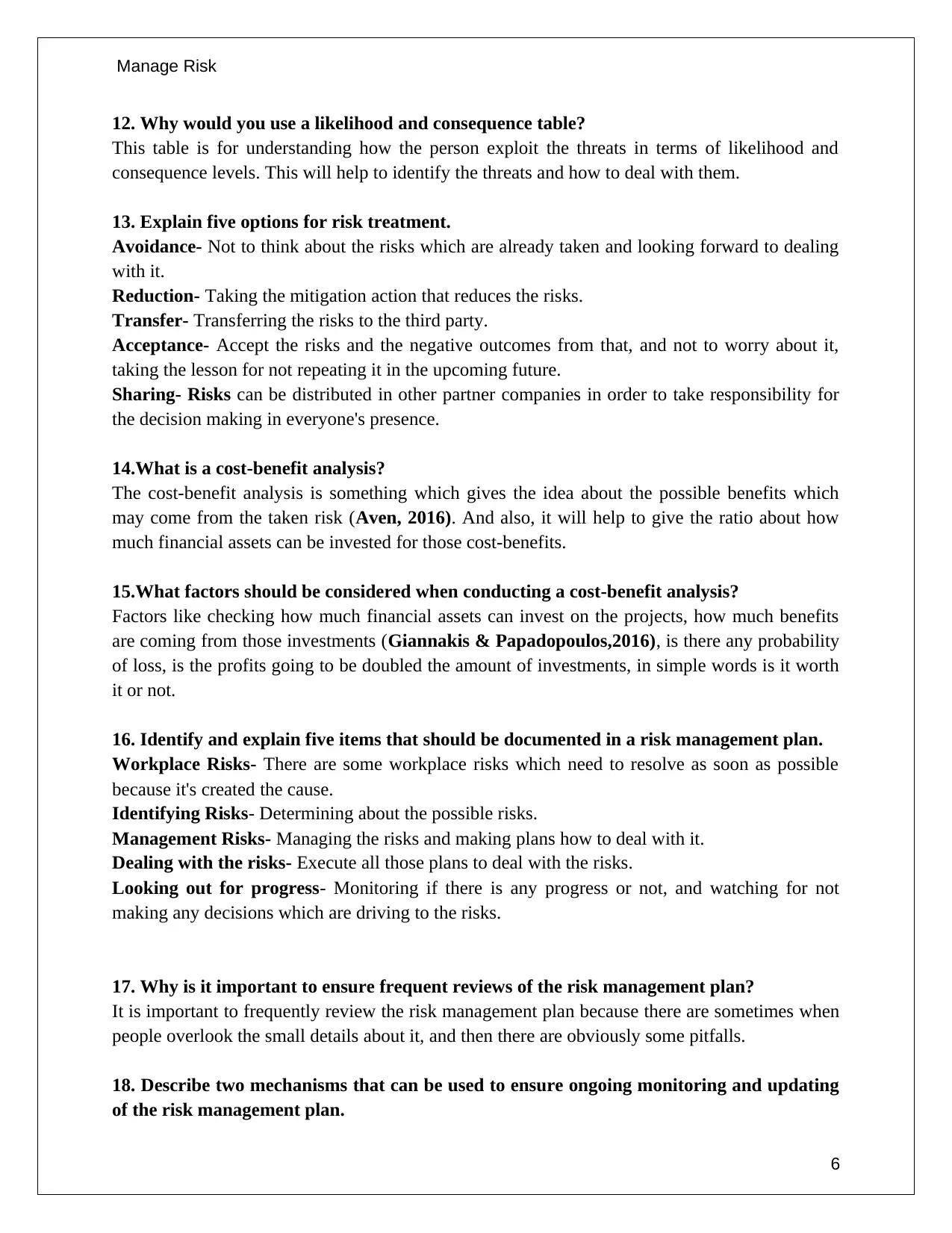
Manage Risk
12. Why would you use a likelihood and consequence table?
This table is for understanding how the person exploit the threats in terms of likelihood and
consequence levels. This will help to identify the threats and how to deal with them.
13. Explain five options for risk treatment.
Avoidance- Not to think about the risks which are already taken and looking forward to dealing
with it.
Reduction- Taking the mitigation action that reduces the risks.
Transfer- Transferring the risks to the third party.
Acceptance- Accept the risks and the negative outcomes from that, and not to worry about it,
taking the lesson for not repeating it in the upcoming future.
Sharing- Risks can be distributed in other partner companies in order to take responsibility for
the decision making in everyone's presence.
14.What is a cost-benefit analysis?
The cost-benefit analysis is something which gives the idea about the possible benefits which
may come from the taken risk (Aven, 2016). And also, it will help to give the ratio about how
much financial assets can be invested for those cost-benefits.
15.What factors should be considered when conducting a cost-benefit analysis?
Factors like checking how much financial assets can invest on the projects, how much benefits
are coming from those investments (Giannakis & Papadopoulos,2016), is there any probability
of loss, is the profits going to be doubled the amount of investments, in simple words is it worth
it or not.
16. Identify and explain five items that should be documented in a risk management plan.
Workplace Risks- There are some workplace risks which need to resolve as soon as possible
because it's created the cause.
Identifying Risks- Determining about the possible risks.
Management Risks- Managing the risks and making plans how to deal with it.
Dealing with the risks- Execute all those plans to deal with the risks.
Looking out for progress- Monitoring if there is any progress or not, and watching for not
making any decisions which are driving to the risks.
17. Why is it important to ensure frequent reviews of the risk management plan?
It is important to frequently review the risk management plan because there are sometimes when
people overlook the small details about it, and then there are obviously some pitfalls.
18. Describe two mechanisms that can be used to ensure ongoing monitoring and updating
of the risk management plan.
6
12. Why would you use a likelihood and consequence table?
This table is for understanding how the person exploit the threats in terms of likelihood and
consequence levels. This will help to identify the threats and how to deal with them.
13. Explain five options for risk treatment.
Avoidance- Not to think about the risks which are already taken and looking forward to dealing
with it.
Reduction- Taking the mitigation action that reduces the risks.
Transfer- Transferring the risks to the third party.
Acceptance- Accept the risks and the negative outcomes from that, and not to worry about it,
taking the lesson for not repeating it in the upcoming future.
Sharing- Risks can be distributed in other partner companies in order to take responsibility for
the decision making in everyone's presence.
14.What is a cost-benefit analysis?
The cost-benefit analysis is something which gives the idea about the possible benefits which
may come from the taken risk (Aven, 2016). And also, it will help to give the ratio about how
much financial assets can be invested for those cost-benefits.
15.What factors should be considered when conducting a cost-benefit analysis?
Factors like checking how much financial assets can invest on the projects, how much benefits
are coming from those investments (Giannakis & Papadopoulos,2016), is there any probability
of loss, is the profits going to be doubled the amount of investments, in simple words is it worth
it or not.
16. Identify and explain five items that should be documented in a risk management plan.
Workplace Risks- There are some workplace risks which need to resolve as soon as possible
because it's created the cause.
Identifying Risks- Determining about the possible risks.
Management Risks- Managing the risks and making plans how to deal with it.
Dealing with the risks- Execute all those plans to deal with the risks.
Looking out for progress- Monitoring if there is any progress or not, and watching for not
making any decisions which are driving to the risks.
17. Why is it important to ensure frequent reviews of the risk management plan?
It is important to frequently review the risk management plan because there are sometimes when
people overlook the small details about it, and then there are obviously some pitfalls.
18. Describe two mechanisms that can be used to ensure ongoing monitoring and updating
of the risk management plan.
6
⊘ This is a preview!⊘
Do you want full access?
Subscribe today to unlock all pages.

Trusted by 1+ million students worldwide
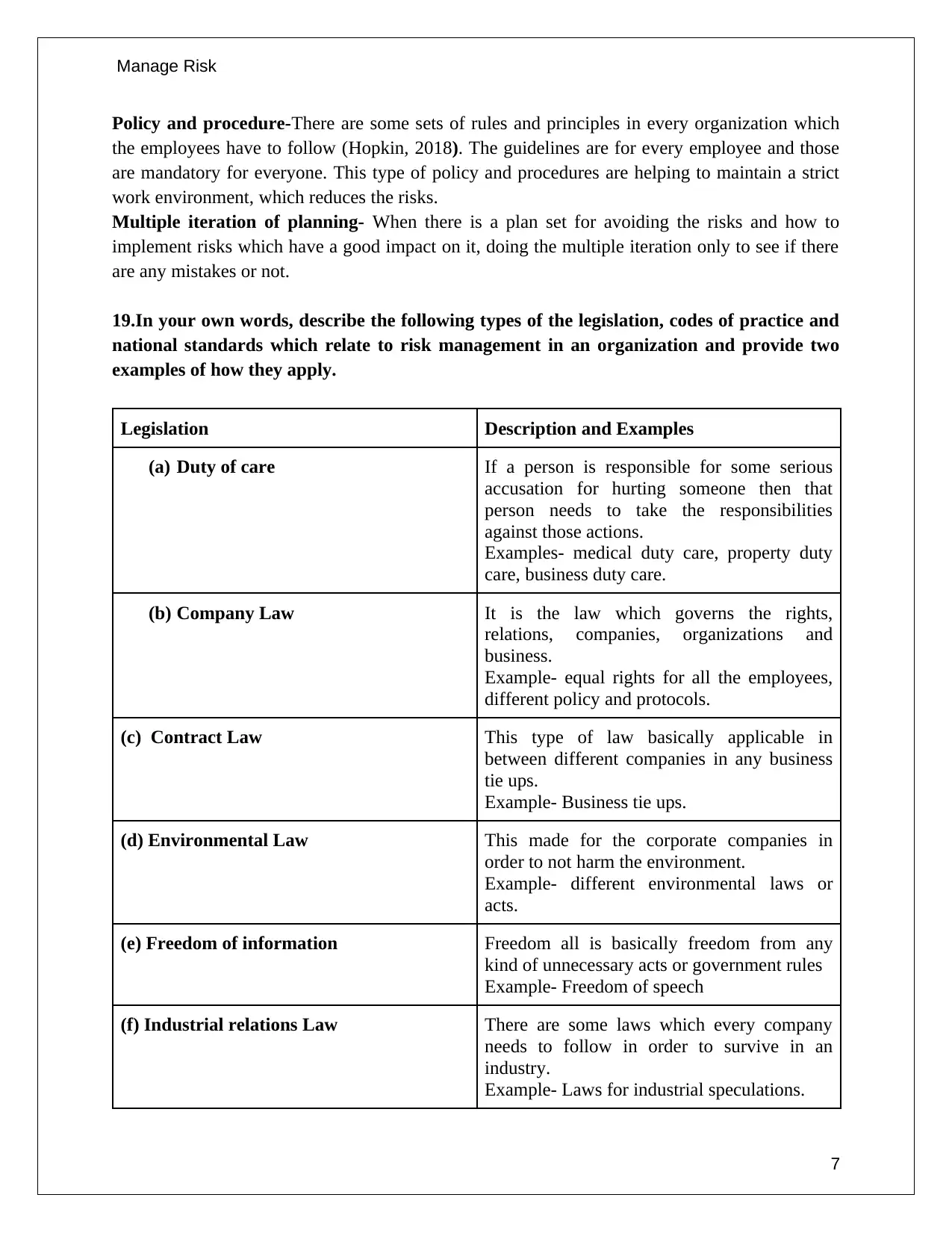
Manage Risk
Policy and procedure-There are some sets of rules and principles in every organization which
the employees have to follow (Hopkin, 2018). The guidelines are for every employee and those
are mandatory for everyone. This type of policy and procedures are helping to maintain a strict
work environment, which reduces the risks.
Multiple iteration of planning- When there is a plan set for avoiding the risks and how to
implement risks which have a good impact on it, doing the multiple iteration only to see if there
are any mistakes or not.
19.In your own words, describe the following types of the legislation, codes of practice and
national standards which relate to risk management in an organization and provide two
examples of how they apply.
Legislation Description and Examples
(a) Duty of care If a person is responsible for some serious
accusation for hurting someone then that
person needs to take the responsibilities
against those actions.
Examples- medical duty care, property duty
care, business duty care.
(b) Company Law It is the law which governs the rights,
relations, companies, organizations and
business.
Example- equal rights for all the employees,
different policy and protocols.
(c) Contract Law This type of law basically applicable in
between different companies in any business
tie ups.
Example- Business tie ups.
(d) Environmental Law This made for the corporate companies in
order to not harm the environment.
Example- different environmental laws or
acts.
(e) Freedom of information Freedom all is basically freedom from any
kind of unnecessary acts or government rules
Example- Freedom of speech
(f) Industrial relations Law There are some laws which every company
needs to follow in order to survive in an
industry.
Example- Laws for industrial speculations.
7
Policy and procedure-There are some sets of rules and principles in every organization which
the employees have to follow (Hopkin, 2018). The guidelines are for every employee and those
are mandatory for everyone. This type of policy and procedures are helping to maintain a strict
work environment, which reduces the risks.
Multiple iteration of planning- When there is a plan set for avoiding the risks and how to
implement risks which have a good impact on it, doing the multiple iteration only to see if there
are any mistakes or not.
19.In your own words, describe the following types of the legislation, codes of practice and
national standards which relate to risk management in an organization and provide two
examples of how they apply.
Legislation Description and Examples
(a) Duty of care If a person is responsible for some serious
accusation for hurting someone then that
person needs to take the responsibilities
against those actions.
Examples- medical duty care, property duty
care, business duty care.
(b) Company Law It is the law which governs the rights,
relations, companies, organizations and
business.
Example- equal rights for all the employees,
different policy and protocols.
(c) Contract Law This type of law basically applicable in
between different companies in any business
tie ups.
Example- Business tie ups.
(d) Environmental Law This made for the corporate companies in
order to not harm the environment.
Example- different environmental laws or
acts.
(e) Freedom of information Freedom all is basically freedom from any
kind of unnecessary acts or government rules
Example- Freedom of speech
(f) Industrial relations Law There are some laws which every company
needs to follow in order to survive in an
industry.
Example- Laws for industrial speculations.
7
Paraphrase This Document
Need a fresh take? Get an instant paraphrase of this document with our AI Paraphraser
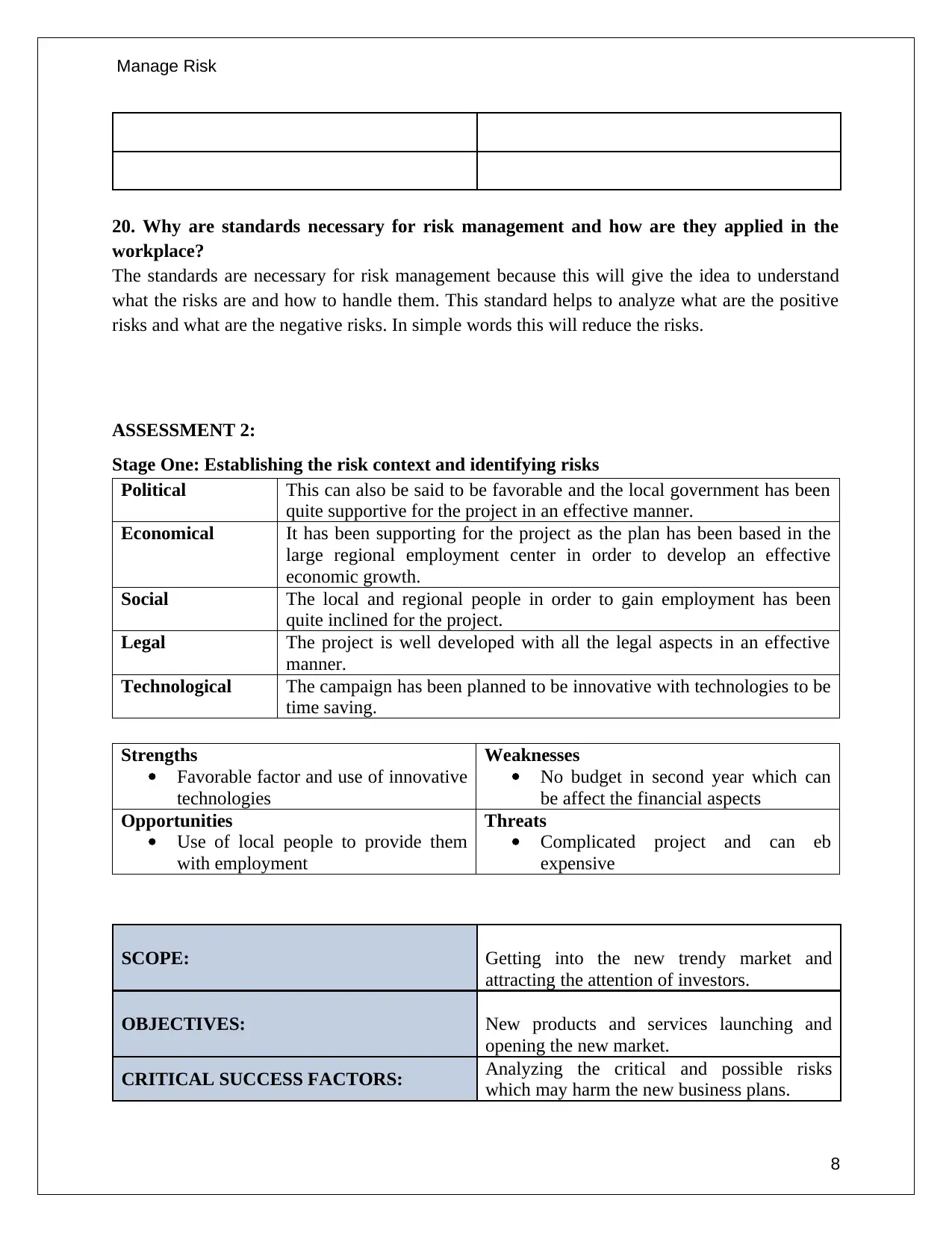
Manage Risk
20. Why are standards necessary for risk management and how are they applied in the
workplace?
The standards are necessary for risk management because this will give the idea to understand
what the risks are and how to handle them. This standard helps to analyze what are the positive
risks and what are the negative risks. In simple words this will reduce the risks.
ASSESSMENT 2:
Stage One: Establishing the risk context and identifying risks
Political This can also be said to be favorable and the local government has been
quite supportive for the project in an effective manner.
Economical It has been supporting for the project as the plan has been based in the
large regional employment center in order to develop an effective
economic growth.
Social The local and regional people in order to gain employment has been
quite inclined for the project.
Legal The project is well developed with all the legal aspects in an effective
manner.
Technological The campaign has been planned to be innovative with technologies to be
time saving.
Strengths
Favorable factor and use of innovative
technologies
Weaknesses
No budget in second year which can
be affect the financial aspects
Opportunities
Use of local people to provide them
with employment
Threats
Complicated project and can eb
expensive
SCOPE: Getting into the new trendy market and
attracting the attention of investors.
OBJECTIVES: New products and services launching and
opening the new market.
CRITICAL SUCCESS FACTORS: Analyzing the critical and possible risks
which may harm the new business plans.
8
20. Why are standards necessary for risk management and how are they applied in the
workplace?
The standards are necessary for risk management because this will give the idea to understand
what the risks are and how to handle them. This standard helps to analyze what are the positive
risks and what are the negative risks. In simple words this will reduce the risks.
ASSESSMENT 2:
Stage One: Establishing the risk context and identifying risks
Political This can also be said to be favorable and the local government has been
quite supportive for the project in an effective manner.
Economical It has been supporting for the project as the plan has been based in the
large regional employment center in order to develop an effective
economic growth.
Social The local and regional people in order to gain employment has been
quite inclined for the project.
Legal The project is well developed with all the legal aspects in an effective
manner.
Technological The campaign has been planned to be innovative with technologies to be
time saving.
Strengths
Favorable factor and use of innovative
technologies
Weaknesses
No budget in second year which can
be affect the financial aspects
Opportunities
Use of local people to provide them
with employment
Threats
Complicated project and can eb
expensive
SCOPE: Getting into the new trendy market and
attracting the attention of investors.
OBJECTIVES: New products and services launching and
opening the new market.
CRITICAL SUCCESS FACTORS: Analyzing the critical and possible risks
which may harm the new business plans.
8
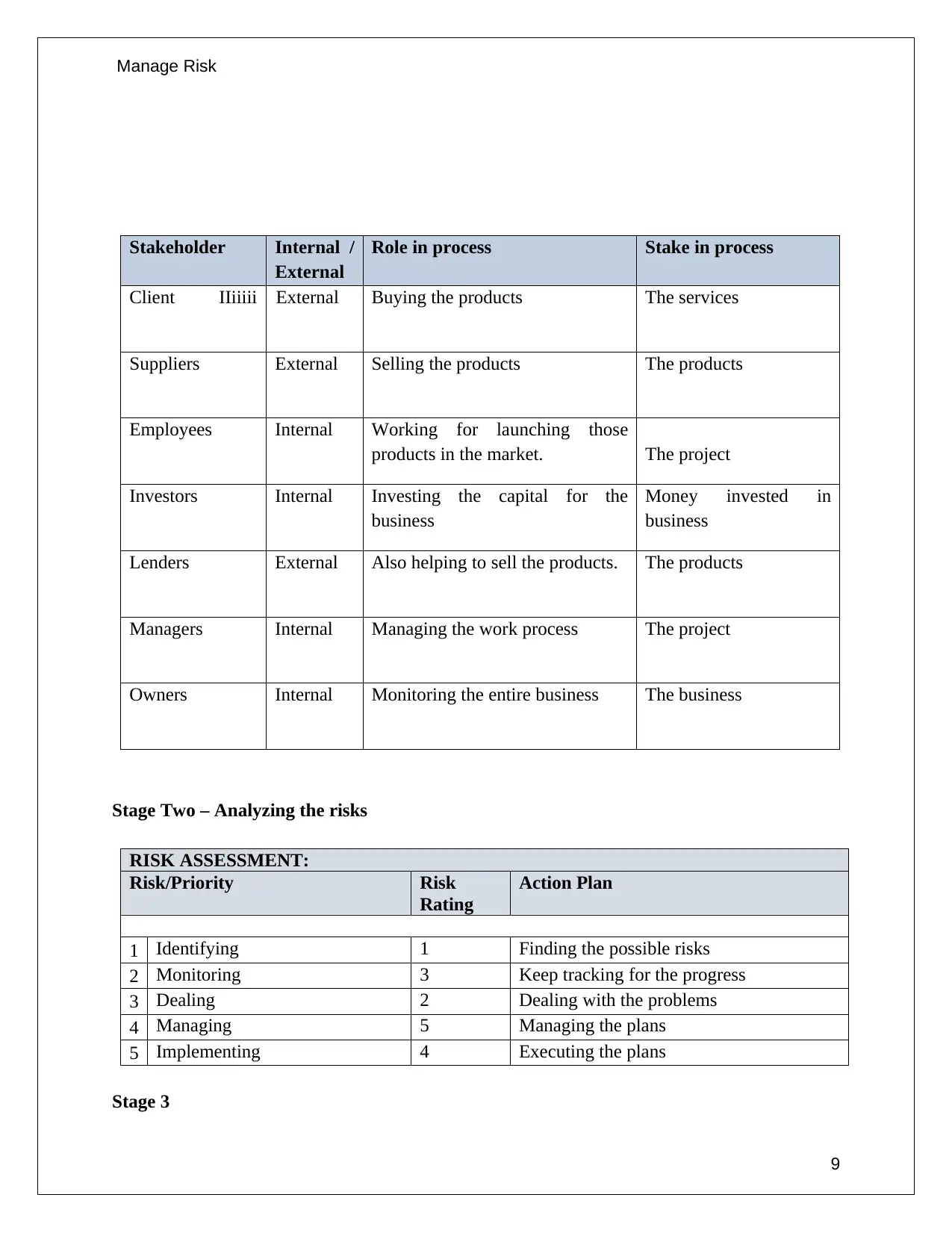
Manage Risk
Stakeholder Internal /
External
Role in process Stake in process
Client IIiiiii External Buying the products The services
Suppliers External Selling the products The products
Employees Internal Working for launching those
products in the market. The project
Investors Internal Investing the capital for the
business
Money invested in
business
Lenders External Also helping to sell the products. The products
Managers Internal Managing the work process The project
Owners Internal Monitoring the entire business The business
Stage Two – Analyzing the risks
RISK ASSESSMENT:
Risk/Priority Risk
Rating
Action Plan
1 Identifying 1 Finding the possible risks
2 Monitoring 3 Keep tracking for the progress
3 Dealing 2 Dealing with the problems
4 Managing 5 Managing the plans
5 Implementing 4 Executing the plans
Stage 3
9
Stakeholder Internal /
External
Role in process Stake in process
Client IIiiiii External Buying the products The services
Suppliers External Selling the products The products
Employees Internal Working for launching those
products in the market. The project
Investors Internal Investing the capital for the
business
Money invested in
business
Lenders External Also helping to sell the products. The products
Managers Internal Managing the work process The project
Owners Internal Monitoring the entire business The business
Stage Two – Analyzing the risks
RISK ASSESSMENT:
Risk/Priority Risk
Rating
Action Plan
1 Identifying 1 Finding the possible risks
2 Monitoring 3 Keep tracking for the progress
3 Dealing 2 Dealing with the problems
4 Managing 5 Managing the plans
5 Implementing 4 Executing the plans
Stage 3
9
⊘ This is a preview!⊘
Do you want full access?
Subscribe today to unlock all pages.

Trusted by 1+ million students worldwide
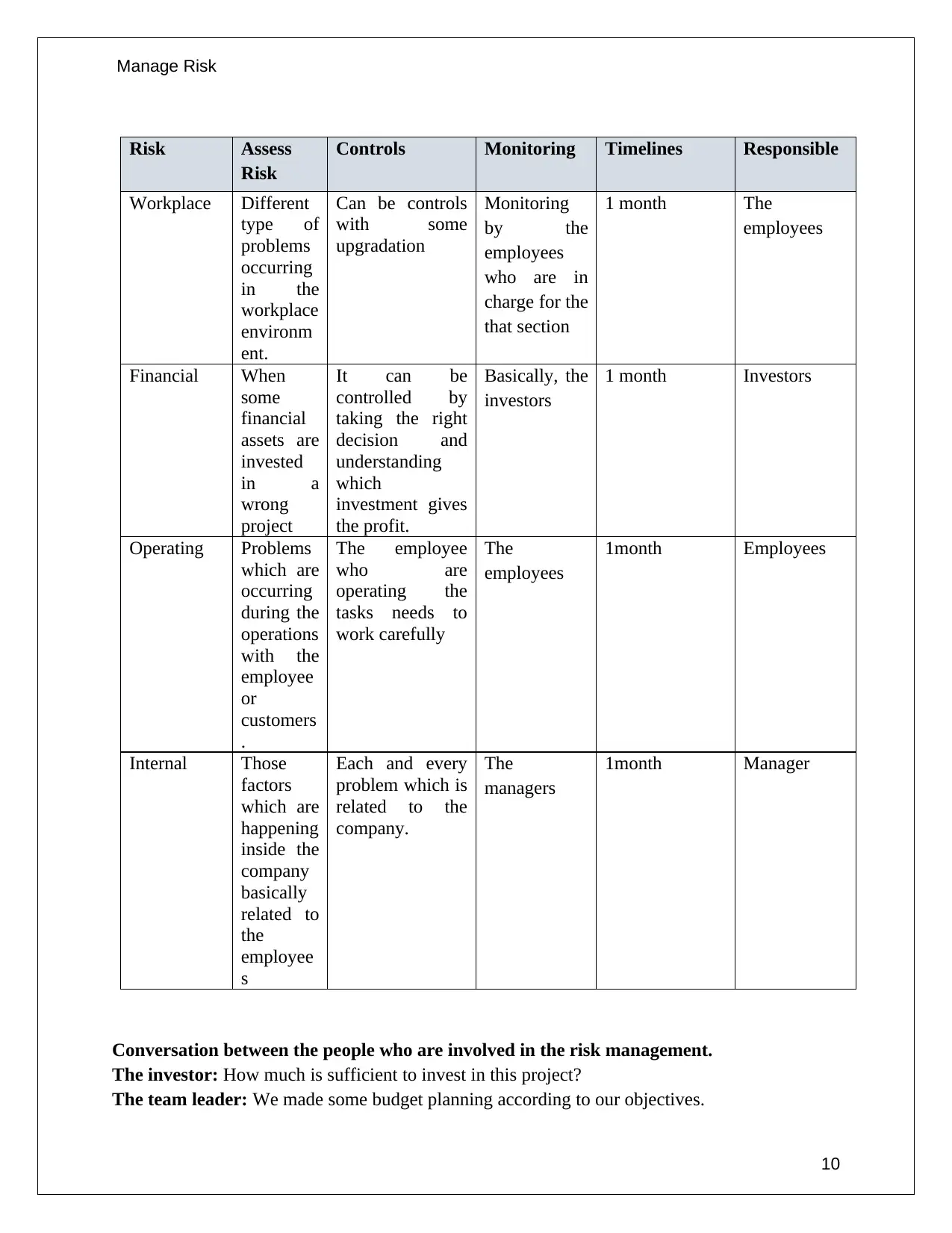
Manage Risk
Risk Assess
Risk
Controls Monitoring Timelines Responsible
Workplace Different
type of
problems
occurring
in the
workplace
environm
ent.
Can be controls
with some
upgradation
Monitoring
by the
employees
who are in
charge for the
that section
1 month The
employees
Financial When
some
financial
assets are
invested
in a
wrong
project
It can be
controlled by
taking the right
decision and
understanding
which
investment gives
the profit.
Basically, the
investors
1 month Investors
Operating Problems
which are
occurring
during the
operations
with the
employee
or
customers
.
The employee
who are
operating the
tasks needs to
work carefully
The
employees
1month Employees
Internal Those
factors
which are
happening
inside the
company
basically
related to
the
employee
s
Each and every
problem which is
related to the
company.
The
managers
1month Manager
Conversation between the people who are involved in the risk management.
The investor: How much is sufficient to invest in this project?
The team leader: We made some budget planning according to our objectives.
10
Risk Assess
Risk
Controls Monitoring Timelines Responsible
Workplace Different
type of
problems
occurring
in the
workplace
environm
ent.
Can be controls
with some
upgradation
Monitoring
by the
employees
who are in
charge for the
that section
1 month The
employees
Financial When
some
financial
assets are
invested
in a
wrong
project
It can be
controlled by
taking the right
decision and
understanding
which
investment gives
the profit.
Basically, the
investors
1 month Investors
Operating Problems
which are
occurring
during the
operations
with the
employee
or
customers
.
The employee
who are
operating the
tasks needs to
work carefully
The
employees
1month Employees
Internal Those
factors
which are
happening
inside the
company
basically
related to
the
employee
s
Each and every
problem which is
related to the
company.
The
managers
1month Manager
Conversation between the people who are involved in the risk management.
The investor: How much is sufficient to invest in this project?
The team leader: We made some budget planning according to our objectives.
10
Paraphrase This Document
Need a fresh take? Get an instant paraphrase of this document with our AI Paraphraser
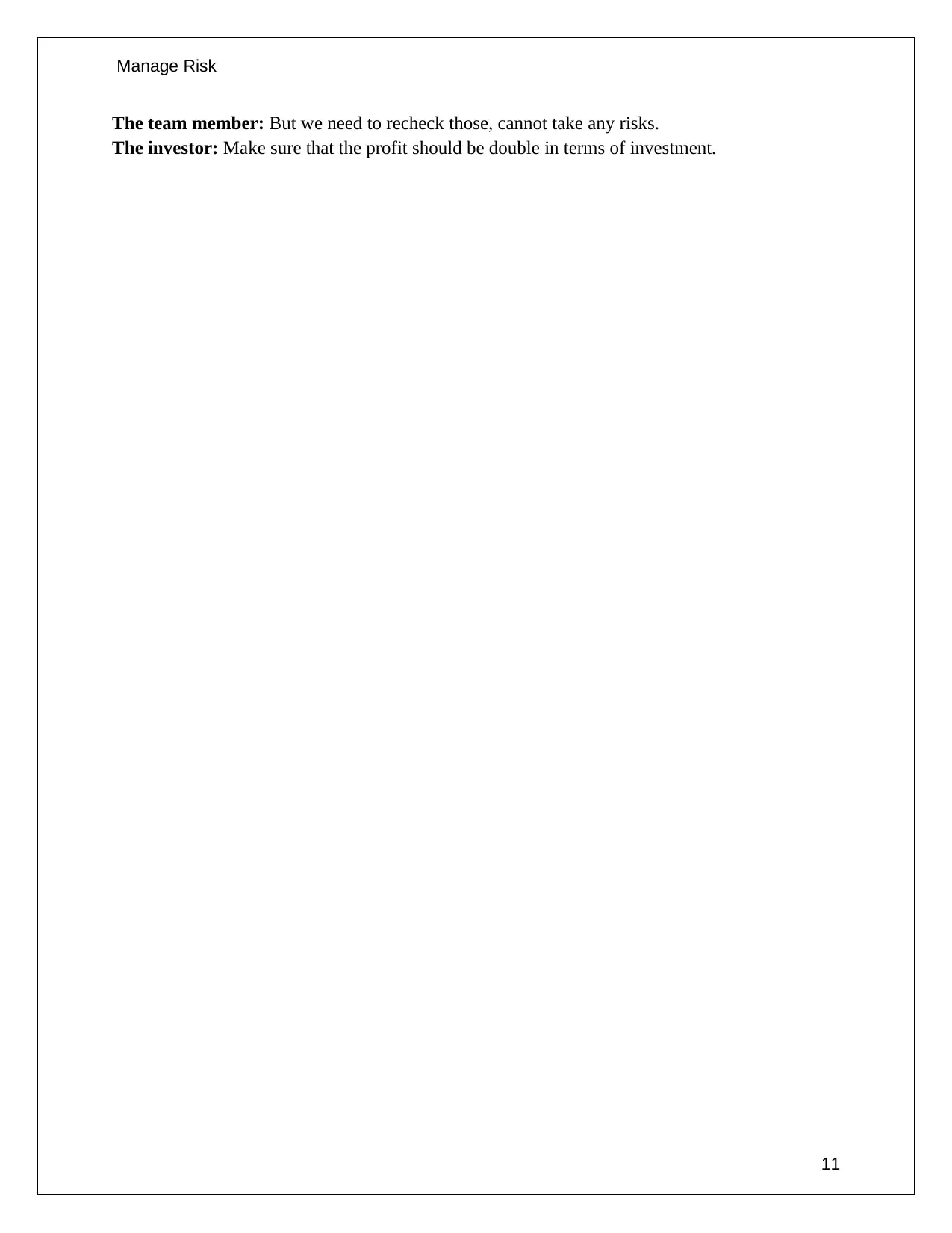
Manage Risk
The team member: But we need to recheck those, cannot take any risks.
The investor: Make sure that the profit should be double in terms of investment.
11
The team member: But we need to recheck those, cannot take any risks.
The investor: Make sure that the profit should be double in terms of investment.
11
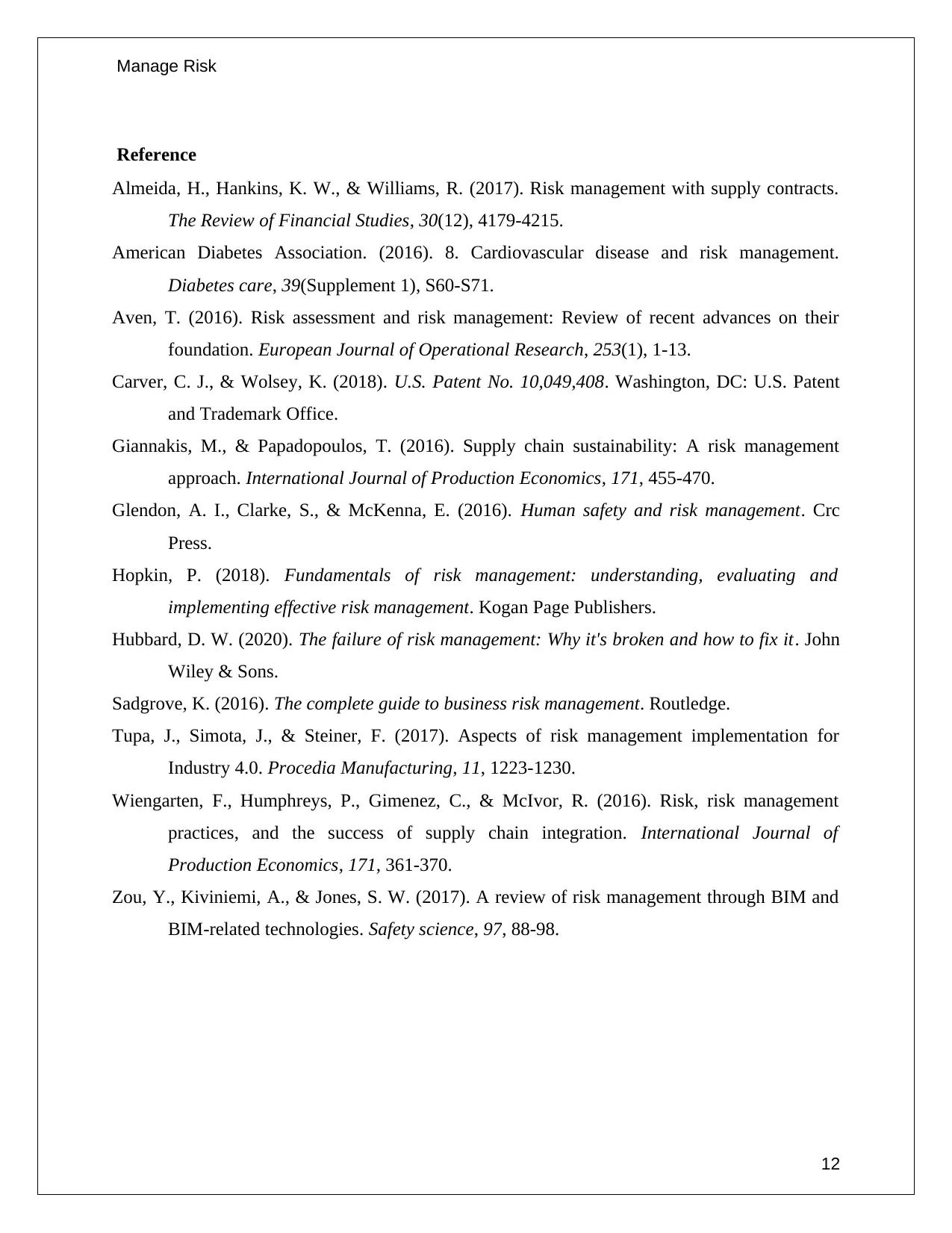
Manage Risk
Reference
Almeida, H., Hankins, K. W., & Williams, R. (2017). Risk management with supply contracts.
The Review of Financial Studies, 30(12), 4179-4215.
American Diabetes Association. (2016). 8. Cardiovascular disease and risk management.
Diabetes care, 39(Supplement 1), S60-S71.
Aven, T. (2016). Risk assessment and risk management: Review of recent advances on their
foundation. European Journal of Operational Research, 253(1), 1-13.
Carver, C. J., & Wolsey, K. (2018). U.S. Patent No. 10,049,408. Washington, DC: U.S. Patent
and Trademark Office.
Giannakis, M., & Papadopoulos, T. (2016). Supply chain sustainability: A risk management
approach. International Journal of Production Economics, 171, 455-470.
Glendon, A. I., Clarke, S., & McKenna, E. (2016). Human safety and risk management. Crc
Press.
Hopkin, P. (2018). Fundamentals of risk management: understanding, evaluating and
implementing effective risk management. Kogan Page Publishers.
Hubbard, D. W. (2020). The failure of risk management: Why it's broken and how to fix it. John
Wiley & Sons.
Sadgrove, K. (2016). The complete guide to business risk management. Routledge.
Tupa, J., Simota, J., & Steiner, F. (2017). Aspects of risk management implementation for
Industry 4.0. Procedia Manufacturing, 11, 1223-1230.
Wiengarten, F., Humphreys, P., Gimenez, C., & McIvor, R. (2016). Risk, risk management
practices, and the success of supply chain integration. International Journal of
Production Economics, 171, 361-370.
Zou, Y., Kiviniemi, A., & Jones, S. W. (2017). A review of risk management through BIM and
BIM-related technologies. Safety science, 97, 88-98.
12
Reference
Almeida, H., Hankins, K. W., & Williams, R. (2017). Risk management with supply contracts.
The Review of Financial Studies, 30(12), 4179-4215.
American Diabetes Association. (2016). 8. Cardiovascular disease and risk management.
Diabetes care, 39(Supplement 1), S60-S71.
Aven, T. (2016). Risk assessment and risk management: Review of recent advances on their
foundation. European Journal of Operational Research, 253(1), 1-13.
Carver, C. J., & Wolsey, K. (2018). U.S. Patent No. 10,049,408. Washington, DC: U.S. Patent
and Trademark Office.
Giannakis, M., & Papadopoulos, T. (2016). Supply chain sustainability: A risk management
approach. International Journal of Production Economics, 171, 455-470.
Glendon, A. I., Clarke, S., & McKenna, E. (2016). Human safety and risk management. Crc
Press.
Hopkin, P. (2018). Fundamentals of risk management: understanding, evaluating and
implementing effective risk management. Kogan Page Publishers.
Hubbard, D. W. (2020). The failure of risk management: Why it's broken and how to fix it. John
Wiley & Sons.
Sadgrove, K. (2016). The complete guide to business risk management. Routledge.
Tupa, J., Simota, J., & Steiner, F. (2017). Aspects of risk management implementation for
Industry 4.0. Procedia Manufacturing, 11, 1223-1230.
Wiengarten, F., Humphreys, P., Gimenez, C., & McIvor, R. (2016). Risk, risk management
practices, and the success of supply chain integration. International Journal of
Production Economics, 171, 361-370.
Zou, Y., Kiviniemi, A., & Jones, S. W. (2017). A review of risk management through BIM and
BIM-related technologies. Safety science, 97, 88-98.
12
⊘ This is a preview!⊘
Do you want full access?
Subscribe today to unlock all pages.

Trusted by 1+ million students worldwide
1 out of 12
Related Documents
Your All-in-One AI-Powered Toolkit for Academic Success.
+13062052269
info@desklib.com
Available 24*7 on WhatsApp / Email
![[object Object]](/_next/static/media/star-bottom.7253800d.svg)
Unlock your academic potential
Copyright © 2020–2025 A2Z Services. All Rights Reserved. Developed and managed by ZUCOL.




